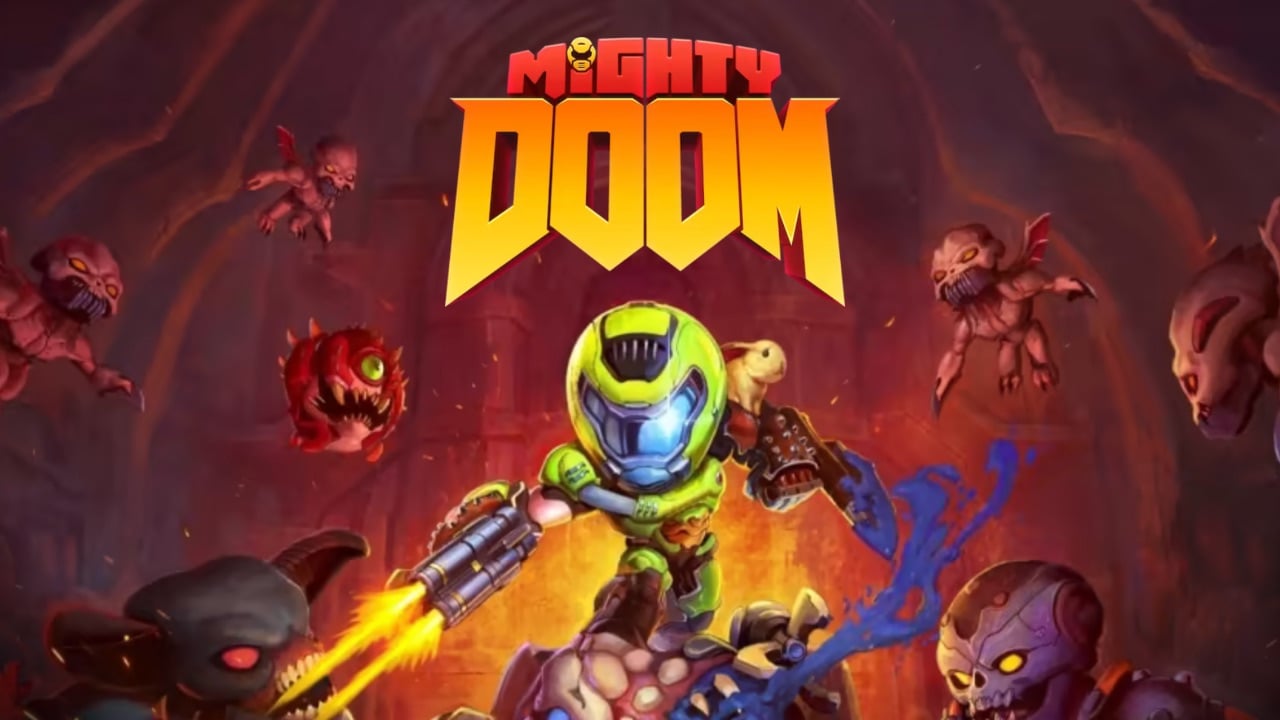Doom Game Order: A Player's Guide To Chronological Gameplay

Table of Contents
Understanding the Doom Timeline
Navigating the Doom timeline can be tricky. Unlike some franchises with a strictly linear narrative, the Doom series features retcons, reboots, and multiple universes, making the ideal Doom game order a matter of some debate. Understanding these complexities is key to enjoying the series to its fullest.
-
Major Eras: The Doom timeline is broadly divided into two major eras: the Classic Doom era (featuring the original games) and the reboot era (starting with the 2016 Doom game).
-
Different Universes/Reboots: The original Doom games (1993-1996) exist in a separate universe from the 2016 reboot and its sequels. While some thematic elements and monster designs carry over, the overarching narratives are distinct. The reboot effectively establishes a new continuity.
-
Timeline Discrepancies: The connections between the various Doom games are not always explicitly stated, leaving room for interpretation and fan theories. This guide focuses on a chronological order based on the established in-universe timelines where possible, acknowledging the inherent complexities.
The Recommended Doom Game Order (Chronological)
This recommended Doom game order prioritizes chronological storytelling within each established universe. We'll start with the classic games, then move onto Doom 3, and finally cover the reboot era.
The Classic Doom Trilogy
This section details the ideal Doom game order for experiencing the original games.
-
Doom (1993): The game that started it all. This iconic first-person shooter introduced the world to the hellish hordes and the iconic Doomguy. The plot revolves around a space marine battling demonic forces on Mars.
-
Doom II: Hell on Earth (1994): The sequel expands upon the original's formula, introducing new demons, weapons, and levels. The action shifts from Mars to Earth, where hell has literally invaded.
-
Doom 64 (1997): A forgotten gem that bridges the gap between Doom II and the next phase of the franchise. It features new levels, weapons, and monsters, offering a unique experience that fans of the original games will want to embrace.
Key Features and Gameplay Differences: The classic Doom games feature a focus on fast-paced, brutal combat with a limited set of weapons and a straightforward narrative. Gameplay evolves slightly over the trilogy, with Doom II adding new features and Doom 64 offering a more polished experience with improved visuals.
Significance: This trilogy cemented Doom's place in gaming history and established many of the series' core elements, including its distinct style and iconic monsters. Playing them in order allows for full appreciation of this gaming legacy.
Doom 3 and its Expansion
-
Doom 3 (2004): A significant departure in style, Doom 3 adopts a darker, more atmospheric approach compared to the fast-paced action of its predecessors. It acts as a prequel to the original Doom games, providing a different perspective on the series' lore.
-
Doom 3: Resurrection of Evil (2005): This expansion enhances the Doom 3 experience with new levels, enemies, and weapons, continuing the story set in the prequel timeline.
Gameplay Shift and Atmosphere: Doom 3 emphasized horror elements and a slower pace, incorporating a more realistic (for the time) visual style. This marked a change in direction, though it later inspired elements in the reboot era.
Narrative Importance: Doom 3 offers a look into the events leading up to the original games, filling in gaps and enriching the overall Doom lore.
The Reboot Era
This section covers the Doom reboot and its sequels. It represents a separate timeline and a significant shift in gameplay.
-
Doom (2016): A revitalization of the series, this game brings back the fast-paced, brutal combat of the originals but with significantly improved graphics, mechanics, and level design. This game effectively resets the timeline.
-
Doom Eternal (2020): The direct sequel to the 2016 reboot, Doom Eternal refines the gameplay further, adding new abilities, enemies, and an even more challenging experience.
-
The Ancient Gods – Part One & Two (2020-2021): These expansions serve as the conclusion to the storyline presented in Doom Eternal, offering additional challenges, story details, and lore within the rebooted universe.
Gameplay Improvements: The reboot era games feature modern graphics and improved mechanics while maintaining the core elements of fast-paced combat that defined the Doom series.
Narrative Connections: The 2016 reboot establishes a new storyline, diverging significantly from the classic Doom universe. It sets up a unique narrative that concludes with The Ancient Gods.
Alternative Play Orders (Considering Gameplay)
While the chronological Doom game order offers the best narrative flow, some players might prefer alternative approaches:
-
Release Date Order (Oldest to Newest): This approach offers a historical perspective, showing the evolution of the series over time.
-
Gameplay Complexity (Easiest to Hardest): Some players might prefer starting with the more accessible classic games before tackling the challenging gameplay of Doom Eternal.
Conclusion
Successfully navigating the Doom game order enhances your overall experience, allowing you to fully appreciate the series' rich history and evolution. Whether you choose a chronological approach or one prioritizing gameplay, understanding the various timelines and iterations will enrich your journey through hell. Start your demonic conquest today by selecting your preferred Doom game order and prepare for a bloody good time! Don’t hesitate to revisit this guide as the Doom universe expands with future releases. Remember to check out other resources and fan discussions to fully immerse yourself in the Doom experience.

Featured Posts
-
 Masyarakat Papua Didorong Dukung Persipura Imbauan Kakanwil Anthonius Ayorbaba
May 13, 2025
Masyarakat Papua Didorong Dukung Persipura Imbauan Kakanwil Anthonius Ayorbaba
May 13, 2025 -
 O Tzortz Mpalntok Giortazei I Anodos Tis Sefilnt Gioynaitent Kai I Fanela
May 13, 2025
O Tzortz Mpalntok Giortazei I Anodos Tis Sefilnt Gioynaitent Kai I Fanela
May 13, 2025 -
 Bar Roma Review Blog Tos Take On This Toronto Hotspot
May 13, 2025
Bar Roma Review Blog Tos Take On This Toronto Hotspot
May 13, 2025 -
 Mlb Home Run Prop Bets Today April 26th Tuckers Hr And More
May 13, 2025
Mlb Home Run Prop Bets Today April 26th Tuckers Hr And More
May 13, 2025 -
 Undrafted Rookie Challenges Top Draft Picks For Roster Spot
May 13, 2025
Undrafted Rookie Challenges Top Draft Picks For Roster Spot
May 13, 2025
Latest Posts
-
 Foto Tragedi Di Myanmar Ribuan Pekerja Terjebak Sindikat Penipuan Online
May 13, 2025
Foto Tragedi Di Myanmar Ribuan Pekerja Terjebak Sindikat Penipuan Online
May 13, 2025 -
 Terungkap Foto Ribuan Korban Penipuan Online Internasional Di Myanmar Wni Teridentifikasi
May 13, 2025
Terungkap Foto Ribuan Korban Penipuan Online Internasional Di Myanmar Wni Teridentifikasi
May 13, 2025 -
 Myanmar Foto Foto Ekspos Jaringan Penipuan Online Libatkan Warga Negara Indonesia
May 13, 2025
Myanmar Foto Foto Ekspos Jaringan Penipuan Online Libatkan Warga Negara Indonesia
May 13, 2025 -
 Potret Pilu Ribuan Pekerja Indonesia Terperangkap Penipuan Online Internasional Di Myanmar
May 13, 2025
Potret Pilu Ribuan Pekerja Indonesia Terperangkap Penipuan Online Internasional Di Myanmar
May 13, 2025 -
 Foto Ribuan Pekerja Terjebak Jaringan Penipuan Online Myanmar Ada Wni
May 13, 2025
Foto Ribuan Pekerja Terjebak Jaringan Penipuan Online Myanmar Ada Wni
May 13, 2025
